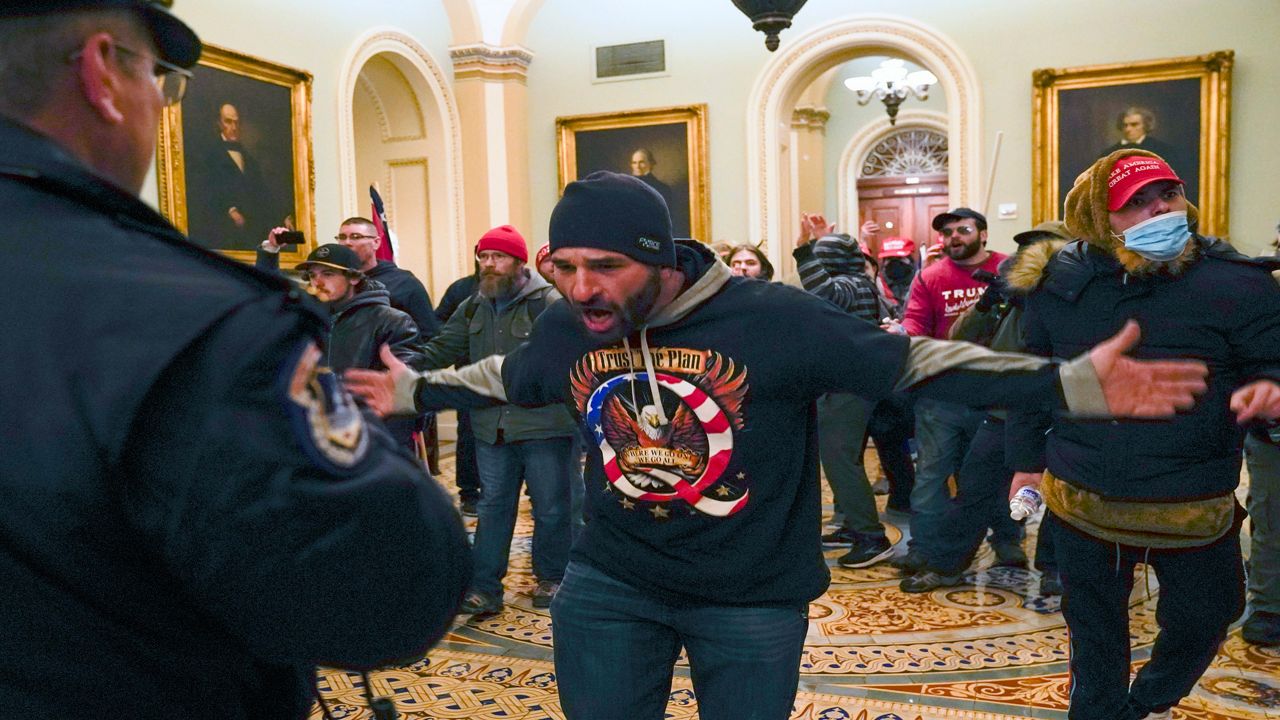Correction: An earlier version of this story incorrectly referred to Richard Burr as a senator from Illinois. Richard Burr is the senior senator from North Carolina. The error has been corrected. (January 9, 2021)
LOUISVILLE, Ky. — The violent mob that ransacked the U.S. Capitol Wednesday, smashing windows and doors before chasing lawmakers from their chambers and occupying the halls of Congress, shocked many Americans.
“I have never lived through or even imagined an experience like the one we have just witnessed in this Capitol,” New York Sen. Chuck Schumer said from the Senate floor, only hours after a shirtless man with an animal pelt on his head posed for photos in the same room.
But not everyone was so surprised. Stetson University political science professor Dr. Steven Smallpage has researched political polarization and conspiracy theories, and he said the chaos has been predictable at least since December 19.
On Dec. 19, 2020, President Trump extended an invitation to his 89 million Twitter followers. (Late Friday, the social network permanently suspended Trump's Twitter account.) “Big protest in D.C. on January 6th,” Trump wrote in a tweet that claimed it was “statistically impossible” for him to have lost the 2020 election. “Be there, will be wild!”
Legions of QAnon conspiracy theorists, who believe Trump has spent years fighting Satan-worshiping, pedophile Democrats, took Trump’s tweet “as literal marching orders,” Smallpage said. The expectation was that January 6 would mark a “new 1776, the refounding of America,” according to Smallpage.
QAnon's influence Wednesday was hardly hidden. Though “Trump 2020” and “Make America Great Again” attire was most prevalent among attendees, many wore shirts emblazoned with a giant “Q.” In the weeks before the siege, popular QAnon social media accounts hyped the event. And in the last 30 days, the phrase “Storm the Capitol” — both a rallying cry and a reference to the QAnon "storm" — was mentioned nearly 1.1 million times on social media, according to the data firm Zignal Labs.
“QAnon was a foundational, fundamental motivating factor” in Wednesday’s assault on the Capitol,” he said.
In the aftermath of Wednesday’s chaos at the Capitol, elected Democrats and Republicans blamed Trump for fanning the flames of conspiracy. "The president bears responsibility for today's events by promoting the unfounded conspiracy theories that have led to this point," North Carolina Sen. Richard Burr said. Schumer said Trump “promoted conspiracy theories that motivated these thugs.”
Trump, in recent weeks, has focused his attention not on Satanic cabals, but on the 2020 election, which he has insisted, without evidence, that he actually won. Smallpage said that those election fraud claims are a gateway to the more outlandish beliefs that consume QAnon believers. Buying into the former often leaders to believing the latter, he said, with social media playing a central role in that progression.
“Not everybody who showed up to that march was a full fledged QAnon conspiracy theorist, but they’re on a spectrum, whether they recognize it or not,” he said.
The conspiracy theorists don’t just include the rioters and the President of the United States. Once the Capitol was cleared, a new conspiracy theory was pushed on the House floor when Florida Congressman Matt Gaetz said the rioters at the Capitol had been infiltrated by left-wing anti-fascist activists.
“Some of the people who breached the Capitol today were not Trump supporters,” he said. “They were masquerading as Trump supporters and, in fact, were members of the violent terrorist group antifa.” The evidence Gaetz cited turned out to be false and there’s no other evidence to suggest antifa, which the FBI calls an ideology, not an organization, was in any way involved with Wednesday’s violence.
Smallpage said the conspiracy theories don’t end there. A new one cropped up Thursday night after Trump tweeted a video in which he acknowledged defeat in the 2020 election for the first time. In the video, Trump said he was “outraged” by the “heinous attack on the United States Capitol.”
“A new administration will be inaugurated on January 20,” he added. “My focus now turns to ensuring a smooth orderly and seamless transition of power.”
Smallpage said that Trump's words do not fit with the narrative that QAnon believers have crafted. So they've concocted a new conspiracy theory alleging that the video posted to Trump’s account is a sophisticated forgery or a deepfake.
He explained the thinking: “They're deepfaking the video because they can't actually get Trump to say those words because he would never say those words, because that would betray the entire movement that he's been building and QAnon has been building this entire time.”
That may sound outlandish, but it’s consistent with the way people who have a conspiracy-oriented ideology think. “It’s all about making sense of the world,” Smallpage said. And for people who are seeing Trump say words that betray them, the most logical explanation is that the video is fake and that Trump himself is dead. “Like, he’s actually been executed," Smallpage said.
